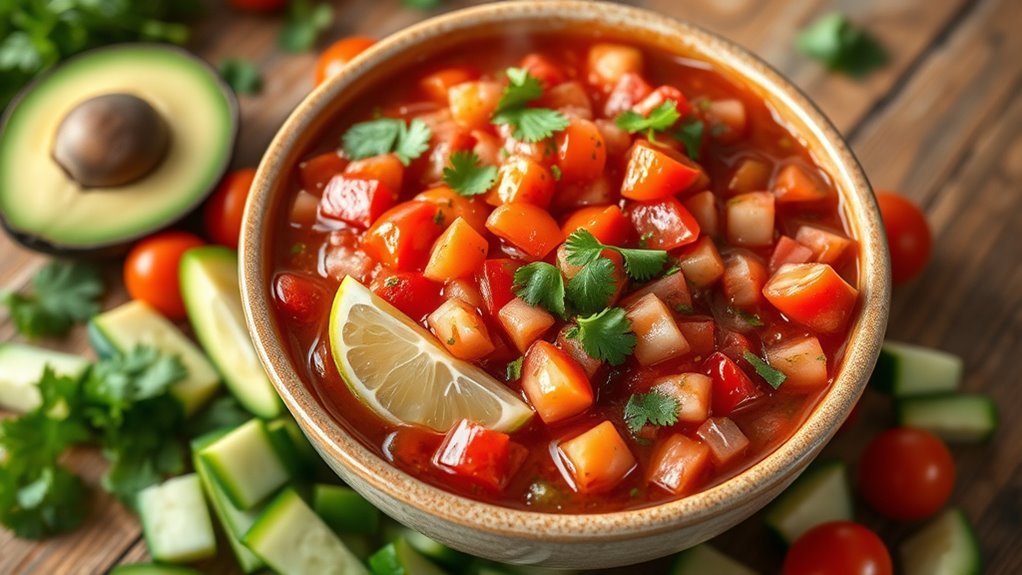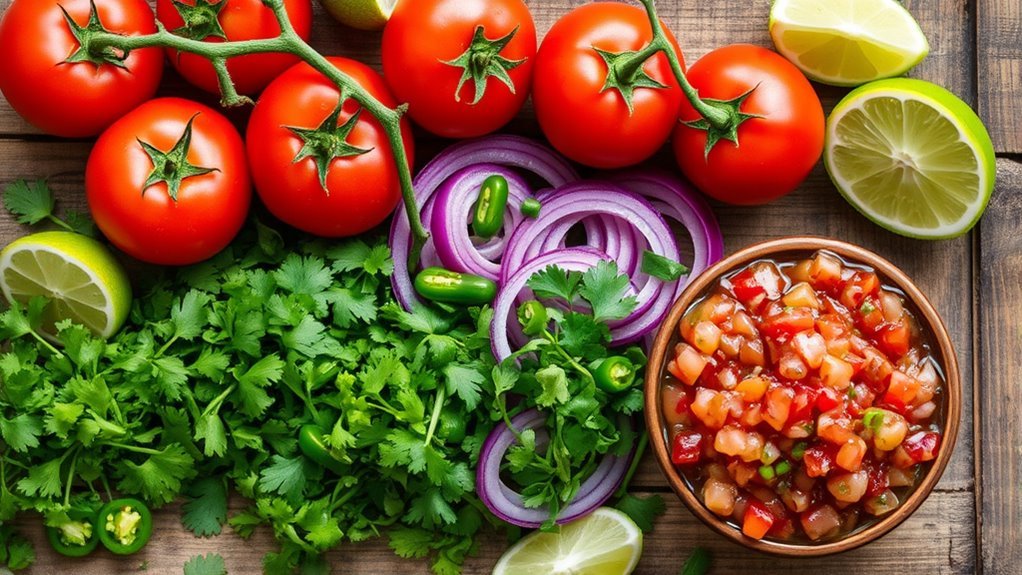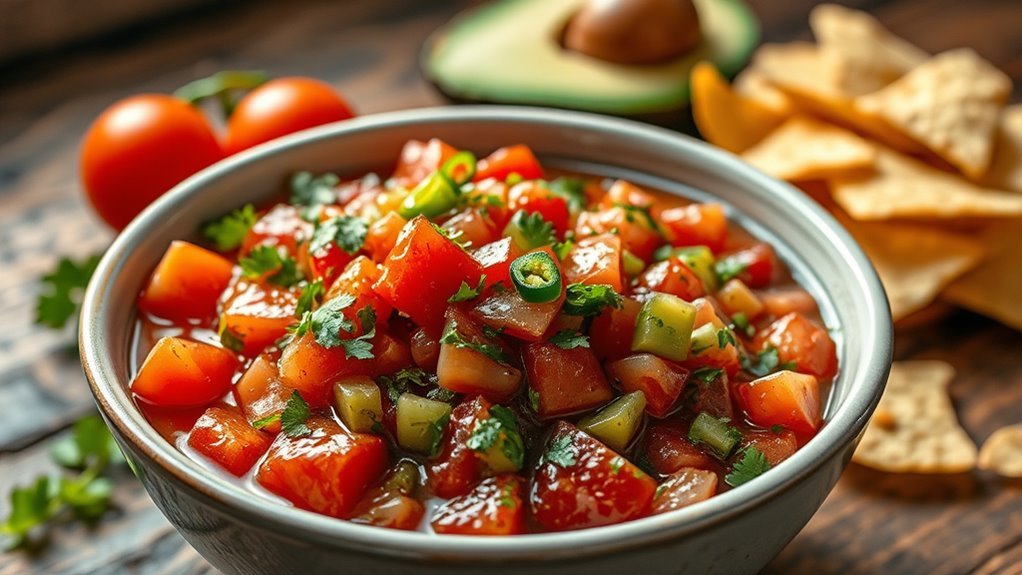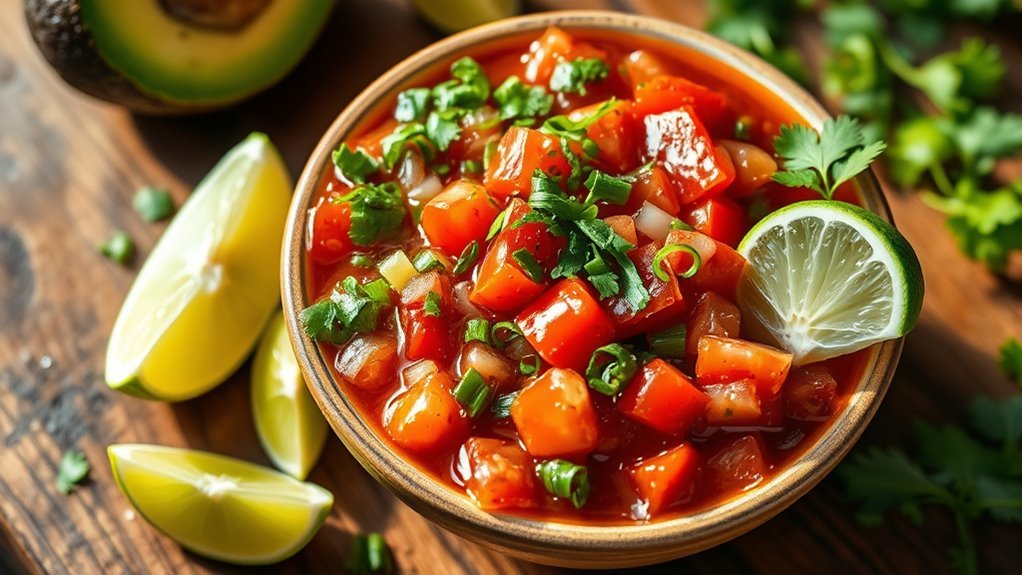Salsa can be a keto-friendly choice if you choose the right ingredients. Look for fresh tomatoes, onions, and peppers while avoiding added sugars and fillers in store-bought versions. One medium tomato has about 5 grams of carbs, while diced onions add around 4 grams. Homemade salsa allows you to control ingredients for lower carbs and better flavor. If you’re curious about how to enjoy salsa while sticking to your keto goals, you might want to explore more ideas.
Understanding the Ingredients in Salsa

When considering whether salsa fits into a keto diet, it’s essential to understand its ingredients. Most salsa varieties are made from tomatoes, onions, peppers, and spices—ingredients that can vary widely in their carb counts. For a keto-friendly option, look for salsas with minimal sugar and high-quality ingredients. You can also explore ingredient substitutions; for example, using fresh tomatoes instead of canned versions can help reduce hidden sugars. Additionally, opting for low-carb vegetables, like bell peppers, can enhance flavor without compromising your diet. Always check labels for added sugars or fillers that can derail your goals. By choosing wisely, you can enjoy salsa while maintaining the freedom of a keto lifestyle. Tomatoes are low in carbohydrates, making them suitable for maintaining ketosis while enjoying flavorful salsa.
Carb Counts of Common Salsa Components

Understanding the carb counts of common salsa components is essential for those following a keto diet. Most salsa ingredients, like tomatoes and onions, contain carbohydrates, but their levels vary. For instance, one medium tomato has about 5 grams of carbs, while a quarter cup of diced onions adds roughly 4 grams. Cilantro and lime juice, often used in salsa, contribute negligible carbs, making them keto-friendly options. Additionally, jalapeños have about 1 gram of carbs per pepper. When considering salsa nutrition, be mindful of added sugars or fillers in store-bought varieties, as these can greatly increase carb counts. By selecting fresh ingredients and monitoring portions, you can enjoy salsa without compromising your keto goals. Incorporating nutrient-dense foods into your diet can further support your keto lifestyle.
Store-Bought vs. Homemade Salsa

Choosing between store-bought and homemade salsa can greatly impact your keto diet. While store-bought options offer convenience, they often contain hidden sugars and preservatives that can derail your efforts. On the other hand, homemade recipes give you complete control over ingredients, ensuring they fit your dietary needs.
Choosing between store-bought and homemade salsa is crucial for your keto diet, impacting ingredient control and overall health.
Consider these points when deciding:
- Ingredient Control: You choose what goes in.
- Freshness: Homemade salsa can be made with fresh produce.
- Flavor Customization: Tailor spice levels to your preference.
- Cost-Effectiveness: Homemade options can save money in the long run.
- Health Benefits: Making salsa at home allows you to incorporate fresh, low-carb ingredients that align with your keto lifestyle.
Ultimately, the choice between store-bought and homemade salsa depends on your lifestyle and commitment to maintaining a keto-friendly diet.
Tips for Choosing Keto-Friendly Salsa
While many salsas may seem keto-friendly at first glance, it’s essential to scrutinize the ingredient list to guarantee they align with your dietary goals. Look for salsas with minimal added sugars and high-quality ingredients. When considering spice levels, choose options that suit your palate without compromising your health. You might also explore ingredient swaps, like using fresh tomatoes instead of canned ones to reduce carb content. Additionally, incorporating low-carb vegetables can enhance the nutritional value of your salsa.
| Salsa Type | Carb Content (per 2 tbsp) | Suggested Ingredient Swaps |
|---|---|---|
| Traditional | 2g | Fresh tomatoes, lime juice |
| Fruit Salsa | 6g | Avocado chunks, jalapeños |
| Green Salsa | 1g | Cilantro, green peppers |
| Roasted Salsa | 3g | Fire-roasted tomatoes, garlic |
| Chunky Salsa | 2g | Diced onions, bell peppers |
Creative Ways to Enjoy Salsa on Keto
Salsa isn’t just a condiment; it can be a versatile addition to your keto meals. You can elevate your dishes while staying on track with your diet. Here are some creative ways to enjoy salsa on keto:
- Pair it with grilled chicken or fish for a revitalizing twist.
- Use it as a topping for avocado boats filled with cheese or meat.
- Stir it into scrambled eggs for a zesty breakfast.
- Mix it with cream cheese to create a flavorful dip for fresh veggies.
These salsa pairings not only enhance flavor but also add nutritional value. Additionally, incorporating low-carb dips like tzatziki can offer even more variety in your meals. Explore different salsa recipes to keep your meals exciting and satisfying while adhering to your keto lifestyle. Enjoy the freedom of variety without compromising your diet!
Frequently Asked Questions
Can I Eat Salsa Every Day on a Keto Diet?
Yes, you can eat salsa every day on a keto diet, but it depends on the salsa varieties you choose. Many salsas are low in carbs, especially those made with fresh ingredients like tomatoes, onions, and peppers. Just be cautious with store-bought options that may contain added sugars. Daily consumption is fine as long as you keep track of your overall carb intake and guarantee it aligns with your keto goals. Enjoy!
Are There Any Health Benefits to Eating Salsa?
Absolutely, eating salsa can offer several health benefits. It’s packed with nutrient density, providing vitamins and minerals like vitamin C and potassium. Plus, its antioxidant properties, primarily from tomatoes and peppers, help combat oxidative stress, supporting your overall health. Incorporating salsa into your meals not only adds flavor but also contributes to a balanced diet. So, enjoy that zesty dip knowing you’re benefiting your body while savoring freedom in your culinary choices!
How Long Does Homemade Salsa Last in the Fridge?
Homemade salsa typically lasts about 5 to 7 days in the fridge when stored properly. For ideal homemade salsa storage, keep it in an airtight container to maintain freshness and prevent contamination. The salsa shelf life can vary based on ingredients and storage conditions, so always check for signs of spoilage, like off smells or changes in texture. Enjoy your salsa within the week for the best flavor and quality!
Is Salsa Safe for People With Food Allergies?
Yes, salsa can be safe for people with food allergies, but it really depends on the ingredients used. You should always check for allergens in the recipe. Many store-bought salsas contain additives that aren’t safe for everyone. By making homemade salsa, you gain complete ingredient awareness, allowing you to avoid allergens. Always communicate your allergies if you’re sharing, ensuring you can enjoy this delicious dip without worry. Your safety and freedom to enjoy food matter!
Can I Freeze Salsa for Later Use?
Yes, you can freeze salsa for later use. To do this effectively, use proper freezing techniques such as portioning it into airtight containers or freezer bags, leaving some space for expansion. This salsa storage method helps maintain flavor and texture. Just remember to label your containers with the date. When you’re ready to use it, thaw it in the refrigerator overnight for best results. Enjoy your flavorful salsa anytime!


